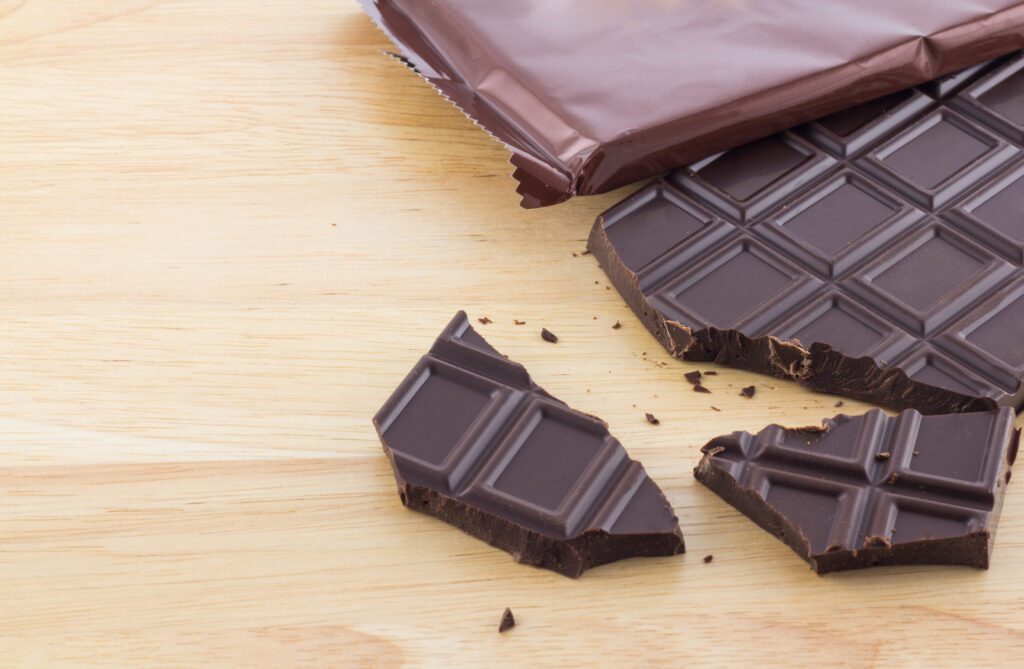A chocolate bar is a solid, shaped product containing chocolate made with some or all of the following: cocoa solids, cocoa butter, sugar, and milk. It may also contain emulsifiers such as soy lecithin or sunflower lecithin to manage its consistency, and/or flavorings such as vanilla.
Some chocolate bars may have vegetable fat added or used as a replacement for cocoa butter (e.g. vegetable oil added or used as replacement for cocoa butter to reduce the amount of cocoa butter required) but these are known as compound chocolate and are not considered as fine chocolate.
However, the addition of vegetable fats other than cocoa butter, up to a maximum of 5%, to chocolate is allowed in certain EU Member States.
A chocolate bar would have the property that they can be snapped into smaller pieces. The earliest recorded history of chocolate bar making is from 1826 by François-Louis Cailler.
There are regional variations in what constitutes a chocolate bar: in the USA and Canada, bars of solid chocolate, either in plain form or containing other ingredients (e.g. nuts, fruit, caramel, nougat, and wafers etc) that are incorporated as inclusions are called chocolate bars.
However, in many other countries, chocolate bars also include other layered ingredients with an outer coating in chocolate. These would usually be referred to as candy bars in USA and Canada.
In a bar of solid chocolate, the cocoa content would usually be specified for a bar of chocolate (with no inclusions) – this is the percentage of total weight of cocoa solids and cocoa butter in the chocolate bar.
The term “bar” encompasses many different shapes, and not just rectangular/oblong ones. The term “chocolate bar” does not imply a minimum weight, shape, thickness, or size.
Sometimes chocolate bar may also be known by different names:
- Chocolate tablet / tablettes – coming from the French term “tablette de chocolat”. Note that “barres de chocolat” would be the equivalent of candy bar in the USA/Canada
- Chocolate slab or bark is usually a large flat piece of chocolate bar that may come in irregular shapes because each piece is broken from a very large piece of chocolate. Chocolate bark usually has inclusion pieces on top to create an uneven or rough texture that resembles a tree bark. Pieces or ‘shards’ from a chocolate slab or bark would be unlikely to be referred to as a “chocolate bar” as it is a smaller part of a whole. Small producers may, where creating a specific shape is not possible, or as a house style, produce and market a “chocolate bar” which is a part of a larger slab of chocolate. This is not common.
Próximamente versión en español


Entry added: March 31, 2023
Verified on: September 14, 2023
Authored by
Albert Chau, General Manager, Fifth Dimension Chocolates Ltd
Chocolatier
George Gensler, Founding Member, Manhattan Chocolate Society / Contributing Editor / Social Media Director, Dessert Professional / Compliance Consultant / Contract Management Specialist / Permanent Grand Jury Member, International Chocolate Awards
Media professional / Educator
Judith Lewis, Owner & Chief Blogger, Mostly About Chocolate / Founder, Decabbit Consultancy / Board Member, Academy of Chocolate
Journalist
References
“CPG Sec 515.800 Labeling of Products Purporting to be “Chocolate” or “Chocolate Flavored”,” USA Food & Drug Administration (FDA), May 1988
“Labelling requirements for confectionery, chocolate and snack food products” Canadian Food Inspection Agency (accessed on April 6, 2023)
“DIRECTIVE 2000/36/EC OF THE EUROPEAN PARLIAMENT AND OF THE COUNCIL of 23 June 2000 relating to cocoa and chocolate products intended for human consumption,” Official Journal of the European Communities, June 23, 2000
Du cacao au chocolate: L’épopée d’une gourmandise, Michel Barel, Éditions Quæ, 2021.
Have a comment on this definition?
